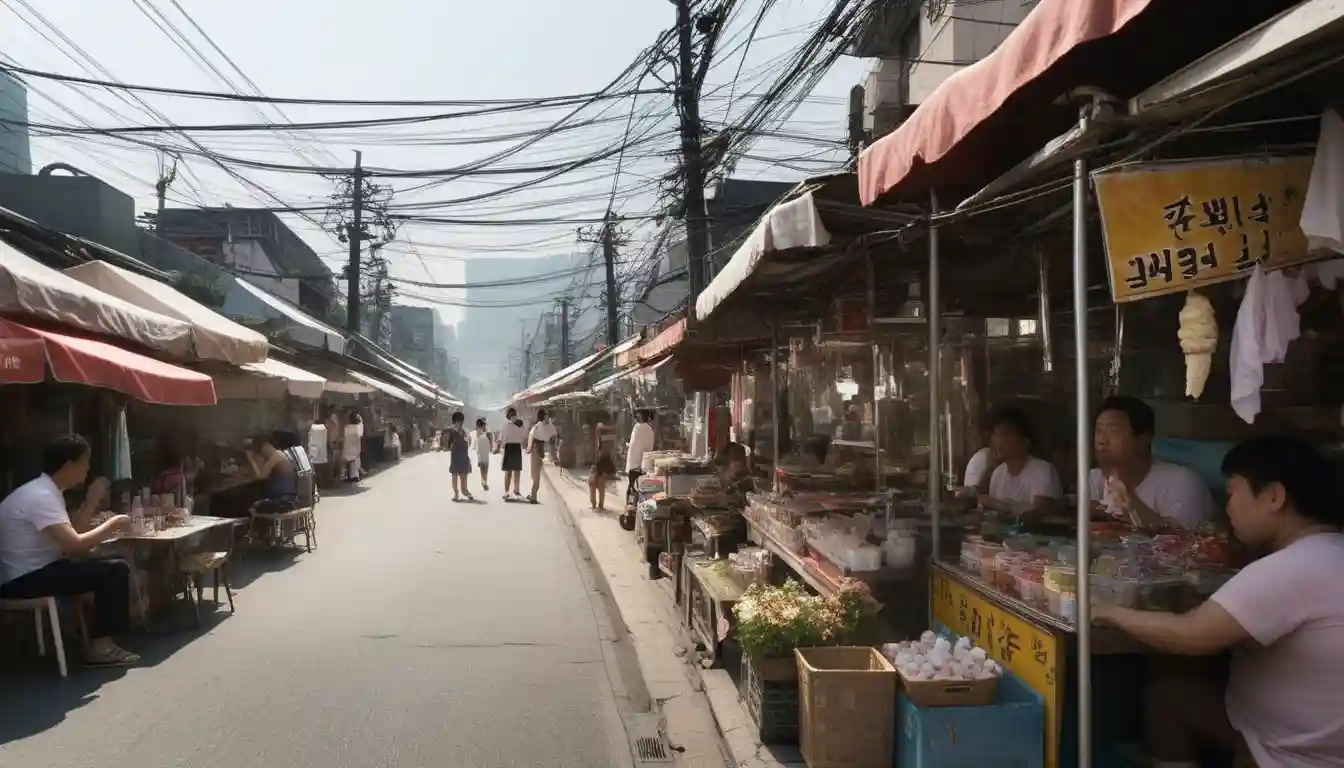
South Korea's Record July Heat Wave Kills 19 People and Pushes Electricity Demand to Historic Highs as Global Cooling Crisis Reshapes Energy Markets
When the Grid Gasps: How Seoul's Scorching Summer Rewrote the Economics of Survival
SEOUL, South Korea — In a cramped apartment overlooking Seoul's Han River, 73-year-old Park Min-ju (nickname) made a choice that would have been unthinkable just a generation ago: she turned off her air conditioning to avoid the mounting electricity bills, even as the temperature outside soared to 38°C.
Three hours later, she collapsed from heat exhaustion: 19 South Koreans died this summer from heat-related illnesses, casualties in a quiet war between human survival and economic reality that is reshaping energy markets across the globe.
Park's story illuminates a profound transformation occurring throughout developed economies in 2025: extreme weather is no longer a temporary disruption but a permanent driver of how societies allocate resources, price risk, and structure their most basic infrastructure. In South Korea, this summer's heat didn't just break records—it broke assumptions about the relationship between climate, energy, and economic stability.

The Numbers Behind the Breaking Point
When South Korea's electrical grid peaked at 85 gigawatts in July—the highest demand since records began in 1993—it represented more than a technical milestone. The 5.6% surge from the previous year captured a nation collectively gasping for relief, as air conditioning became less luxury than life support.
The meteorological assault was relentless: 15 days above 33°C, four times the historical July average, followed by 23 consecutive "tropical nights" where temperatures never dropped below 25°C. In emergency rooms across the country, medical staff witnessed the human cost firsthand as over 3,100 people sought treatment for heat-related conditions—double the number from the same period last year.
"We're seeing patients who've never needed emergency care for heat before," observed one emergency physician at Seoul National University Hospital, speaking on condition of anonymity. "The elderly, yes, but also working-age adults who simply couldn't afford to cool their homes adequately."
Heat exhaustion claimed 61.3% of victims, while heat stroke and heat cramps affected thousands more. The elderly bore the heaviest burden, comprising nearly one-third of all cases, caught between fixed incomes and escalating cooling costs.
A Global Awakening: When Infrastructure Meets Reality
Seoul's struggle represents one movement in a synchronized global symphony of grid stress. Across major economies, July 2025 delivered what market analysts are calling "the great simultaneous shock"—a moment when theoretical climate projections became immediate economic imperatives.
In China, national electricity load exceeded 1.5 terawatts as provincial grids shattered records from Beijing to Guangzhou. European day-ahead electricity prices surged past €90 per megawatt-hour in France, while thermal power plants across the continent reduced output as rivers ran too warm to provide adequate cooling. The human toll proved equally devastating: approximately 2,300 excess deaths occurred across 12 major European cities during just ten days of extreme heat.
The United States braced for potential record-breaking demand exceeding 166 gigawatts, while Japan recorded over 10,800 heat-related hospitalizations in a single week. India projected demand surges approaching 10%—a seemingly modest percentage that translates to tens of millions of people seeking relief from temperatures that regularly topped 44°C.
"What we're witnessing is the arrival of the adaptation economy," noted one senior energy analyst at a major investment bank. "Climate resilience isn't an environmental policy anymore—it's a fundamental business strategy."
The Utility Paradox: When Serving Customers Becomes Unprofitable
The financial implications of this new reality are crystallizing in stark performance differences among utility companies worldwide. Korea Electric Power Corporation , currently trading at $13.13 after losing $0.61 in recent sessions, exemplifies the crushing pressure facing regulated utilities unable to pass escalating costs to consumers.
Every kilowatt-hour KEPCO sold during July's heat spikes eroded profit margins, as the company's regulated tariff structure prevented real-time pricing adjustments. The South Korean government's decision to extend progressive electricity rate brackets—essentially subsidizing peak consumption—further compounded the earnings squeeze, creating a perverse incentive where serving desperate customers during life-threatening heat waves became a path to financial distress.
Meanwhile, NextEra Energy, trading at $70.40, demonstrates how market-oriented utilities can transform extreme weather from liability into opportunity. The company's portfolio of contracted solar-plus-storage projects provides both revenue stability and the flexibility to capture price premiums during peak demand periods.
"We're entering an era where utility business models will bifurcate completely," explained one portfolio manager specializing in infrastructure investments. "Regulated utilities serving basic needs will face perpetual margin compression, while those with pricing flexibility and renewable portfolios will prosper."
The Cooling Revolution: From Comfort to Necessity
Behind the statistics lies a fundamental shift in human behavior and market dynamics. Air conditioning systems, once considered discretionary purchases in temperate climates, are rapidly becoming survival necessities—driving what economists term the "defensive technology boom."
Chinese air conditioning sales surged 45% year-over-year, while Indian consumers increased cooling equipment purchases by 40-50%. This demand explosion is reshaping entire industries, from residential construction to commercial real estate, as building designs prioritize heat resilience over traditional aesthetics or cost optimization.
The labor market reflects this transformation directly. Italy, France, and Spain imposed or expanded heat-work bans this summer, forcing construction companies to adopt shift premiums and invest in specialized cooling equipment for outdoor workers. What began as worker protection measures are evolving into fundamental cost structures that will permanently alter construction economics.
"The regulatory framework is catching up to physical reality," observed one construction industry executive. "Heat protection isn't seasonal accommodation anymore—it's year-round operational planning."
Carbon Markets Confront the Cooling Imperative
The atmospheric consequences of synchronized cooling demand are materializing faster than policy frameworks can adapt. European Union carbon credit prices reflect an anticipated 14% month-over-month increase in fossil fuel usage as traditional renewables prove insufficient during evening peak demand periods—precisely when air conditioning loads remain elevated but solar generation vanishes.
This dynamic exposes a crucial infrastructure gap: the storage chasm between installed renewable capacity and available electricity during the critical evening hours when cooling needs persist. Battery storage systems, once considered supplementary grid assets, are rapidly becoming essential infrastructure for climate adaptation.
Asian LNG markets, despite broader economic concerns keeping spot prices around $12.3 per million BTU, show signs of structural tightening as utilities across the region secure backup generation capacity for future heat episodes. Market participants expect significant price volatility as Asian buyers restock inventories ahead of what meteorologists predict could be another challenging winter.
Investment Implications: The Adaptation Economy Takes Shape
For institutional investors, the July 2025 heat cycle offers unusually clear directional signals amid broader market uncertainty. The convergence of record electricity demand, infrastructure stress, and regulatory response across multiple developed economies suggests several investable themes.
Grid modernization companies appear positioned for sustained capital expenditure cycles as utilities confront the reality of higher, more volatile demand patterns. Energy storage integrators and battery manufacturers face similar tailwinds as grid operators recognize storage as essential infrastructure rather than optional efficiency enhancement.
The cooling technology sector is experiencing fundamental demand transformation. Companies developing high-efficiency HVAC systems, smart building controls, and thermal management solutions are transitioning from niche markets to defensive necessities with regulatory support.
Insurance markets face recalibration pressure as property casualty carriers confront mounting climate-related claims. Commercial real estate portfolios lacking adequate cooling and heat-resilience retrofits may experience systematic repricing as tenant demands and regulatory requirements evolve.
Resilience Through Innovation
Yet within these challenges, innovative responses are emerging. Community cooling centers are expanding beyond emergency measures into permanent social infrastructure. Corporate employers are redesigning work schedules and facility management around heat stress prevention. Municipal governments are integrating cooling access into public health planning.
The same market forces driving infrastructure stress are spurring technological innovation in building materials, urban design, and energy efficiency. Phase-change materials, reflective surfaces, and passive cooling systems are experiencing breakthrough adoption as both cost pressures and regulatory requirements align with technological capability.
"We're witnessing the birth of climate-adaptive capitalism," suggested one senior researcher at a major policy institute. "Market mechanisms are finally pricing physical reality correctly."
The story that began with Park Min-ju's impossible choice between financial security and physical survival is evolving into a broader narrative of systematic adaptation. As August temperatures threaten to surpass July's records, South Korea and other heat-stressed economies are discovering that resilience, not just efficiency, has become the organizing principle of twenty-first-century infrastructure investment.
The grid may have gasped under July's heat, but the economic response suggests it will emerge both stronger and more expensive—powered by the recognition that survival itself has become a premium service requiring premium investment.
This analysis reflects current market conditions and established economic indicators. Past performance does not guarantee future results, and investors should consult financial advisors for personalized investment guidance.